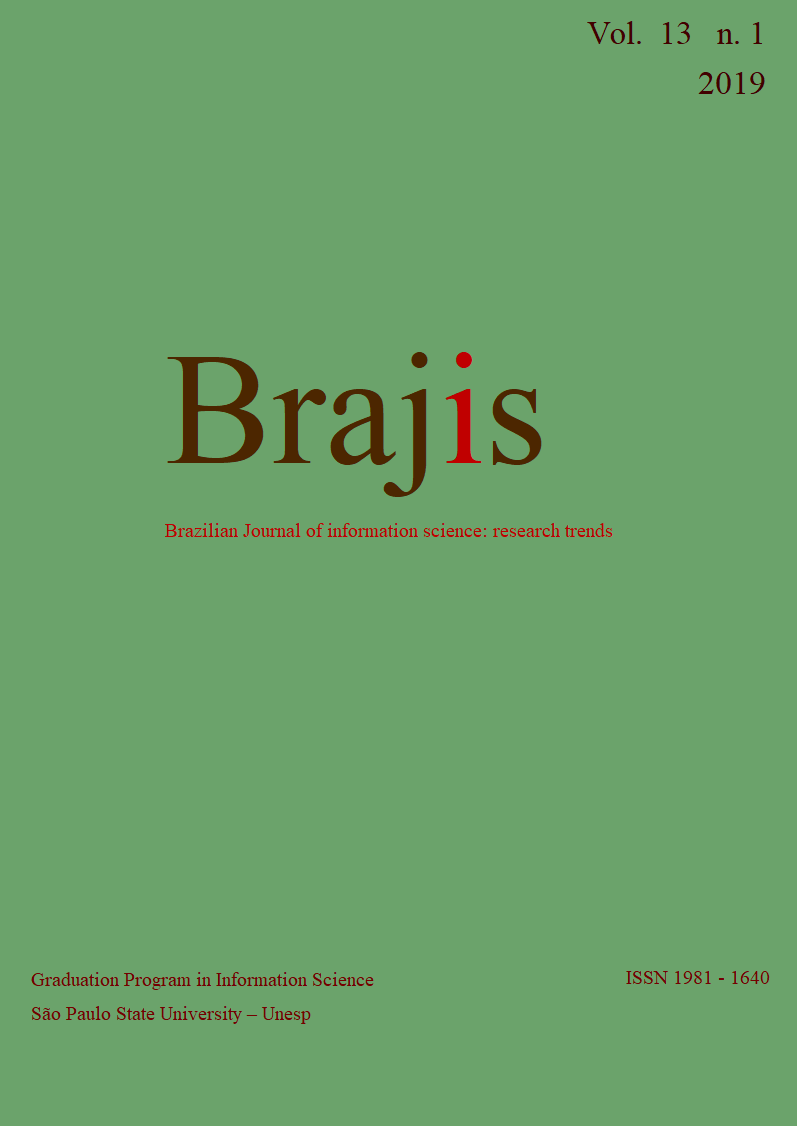Big data and data science
conceptual complementarity in the decision-making process
DOI:
https://doi.org/10.36311/1981-1640.2019.v13n1.06.p56Keywords:
Big Data, Data Science, Decision-Making Process, Knowledge-Intensive TasksAbstract
Nowadays, huge databases are produced in a wide range of domains due to the evolution and the massive use of the Information and Communication Technologies. Therefore, the development of instruments for extracting information from Big Data and fostering actionable knowledge in Decision-Making Processes arise interest by several organizations. In this context, the evolution of data ? information ? knowledge requires the synergy of competences in a new domain, the Data Science. Among the activities of that domain, can be cited: obtaining data from various sources distributed on the web; creating models for handling data and metadata; and planning the exploration of data and metadata to produce relevant information in Decision-Making Processes. Considering these statements, this paper aims to discuss the difference and the complementarity between the Big Data and Data Science concepts. As a result, it is pointed out that Big Data delineates the cloud computing services for storing, processing and distributing data resources. Regarding to Data Science, it is a concept related to the use of software for transforming data into information, supporting the decision makers when dealing with the Knowledge-Intensive Tasks.
Downloads
References
Akhtat,Syed Muhammad Fahad (2018). Big Data Architect’s Hand-book. Birmingham: Pack Publishing, 2018.
Blum, Avrim; Hopcroft, John; Kannan, Ravi (2018). FoundationsofDataScience(2018). https://www.cs.cornell.edu/jeh/book.pdf(2018-07-26).
Bugnion, Pascal; Manivannan, Arun; Nicolas, Patrick R. (2017). Scala: Guide for Data Science Professionals. Birmingham: Packt Publishing, 2017.
Conamay, Drew (2010). The data science venn diagram (2010). http://drewconway.com/zia/2013/3/26/the-data-science-venn-diagram(2018-07-27).
Digital Curation Centre (2018). The DCC Curation Lifecycle Model (2018). http://www.dcc.ac.uk/sites/default/files/documents/publications/DCCLifecycle.pdf (2018-07-25).
Economist, The (2017). Theworld’smostvaluableresourceisnolongeroil, butdata (2017). https://www.economist.com/leaders/2017/05/06/the-worlds-most-valuable-resource-is-no-longer-oil-but-data (2018-07-28).Eiica (2019). X Encontro Internacional de Informação, Conhecimento e Ação. Marília, 2018. http://enancib.marilia.unesp.br/index.php/EIICA/XEIICA. (2019-02-27).
Gartner(2018a). What is Big Data? –Gartner IT Glossary–Big Data (2018a). http://www.gartner.com/it-glossary/big-data(2018-07-28).
Gartner (2018b). Data Scientist –Gartner IT Glossary(2018c). https://www.gartner.com/it-glossary/data-scientist (2018-07-28).
Grady, Nancy; Chang, Wo (2015). NIST Big Data Interoperability Framework: Volume 1, Definitions (2015). https://nvlpubs.nist.gov/nistpubs/SpecialPublications/NIST.SP.1500-1.pdf(2018-07-28).
Laney, Doug (2001). 3D Data Management: Controlling Data Vol-ume, Velocity, and Variety (2001). https://blogs.gartner.com/doug-laney/files/2012/01/ad949-3D-Data-Management-Controlling-Data-Volume-Velocity-and-Variety.pdf(2018-07-25).
Manyika, James; Chui, Michael; Brown, Brad; Bughin, Jacques; Dobbs, Richard; Roxburgh, Charles Byers, Angela Hung (2011). Big data: The next frontier for innovation, competition, and productivity (2011). https://bigdatawg.nist.gov/pdf/MGI_big_data_full_report.pdf(2018-07-28).
Mishra, Sanjay; Chang, Wo (2015). NIST Big Data Interoperability Framework: Volume 5, Security and Privacy (2015). https://nvlpubs.nist.gov/nistpubs/SpecialPublications/NIST.SP.1500-5.pdf(2018-07-28).
Munakata, Toshinori (2008). Fundamentals of the New Artificial Intelligence: Neural, Evolutionary, Fuzzy and More. Heidelberg: Springer, 2008.
National Science Foundation(2005). Long-Lived Digital Data Collections: Enabling Research and Education in the 21st Century (2005). https://www.nsf.gov/pubs/2005/nsb0540/nsb0540.pdf(2018-07-28).
Provost, Foster; Fawcett, Tom (2013). Data Science and its Relationship to Big Data and Data-Driven Decision Making. // Big Data, 1:1 (March2013) 51-59.
Rautenberg, Sandro; Carmo, Paulo Ricardo Viviurka do(2018). Big Data e Ciência de Dados: Complementariedade Conceitual no Processo de Tomada de Decisão. //Encontro Internacional de Informação, Conhecimento e Ação, Marília. Caderno de Resumos. Marília: Unesp, 10, 1, 2018, p.219-221.
Roy, Arnab; Underwood, Mark; Chang, Wo (2015). NIST Big Data Interoperability Framework: Volume 4, Security and Privacy (2015) https://nvlpubs.nist.gov/nistpubs/SpecialPublications/NIST.SP.1500-4.pdf(2018-07-28).
Schreiber, Guss et al (2000). Knowledge Engineering and Management: the Com-monKADS Methodology. Cambridge: The MIT Press, 2000.Swan, Alma; Brown, Sheridan(2008). The Skills, Role and Career Structure of Data Scientists and Curators: an Assessment of Current Practice and Future Needs (2008). http://citeseerx.ist.psu.edu/viewdoc/download?doi=10.1.1.147.8960&rep=rep1&type=pdf(2008-07-28).
Tarasewich, Peter; Mcmullen, Patrick R (2002). Swarm Intelligence: power in numbers. // Communications of the ACM 45:8 (August 2002) 62-66. Van Der Aalst, Wil (2014). Data Scientist: The Engineer of the Future. //Mertins, Kai; Bénaben, Frédérick; Poler, Raul; Bourrières Jean-Paul (eds.) (2014).Proceedings of the Interoperability of Enterprises Systems and Applications Conference (I-ESA’2014): Albi, France. Mar. 24-28, 2014. Heidelberg: Springer.
Downloads
Published
Issue
Section
License
When submitting an article, the authors retain the copyright of the article, giving full rights to the Brazilian Journal of Information Science to publish the text.
The author(s) agree that the article, if editorially accepted for publication, shall be licensed under the Creative Commons Attribution-ShareAlike 4.0 International (CC BY-SA 4.0) license (http://creativecommons.org/licenses/by-sa/4.0) Readers/users are free to: - Share — copy and redistribute the material in any medium or format - Adapt — remix, transform, and build upon the material for any purpose, even commercially. The licensor cannot revoke these freedoms as long as you follow the license terms. Under the following terms: - Attribution — You must give appropriate credit, provide a link to the license, and indicate if changes were made. You may do so in any reasonable manner, but not in any way that suggests the licensor endorses you or your use. - ShareAlike — If you remix, transform, or build upon the material, you must distribute your contributions under the same license as the original. No additional restrictions — You may not apply legal terms or technological measures that legally restrict others from doing anything the license permits. Notices: - You do not have to comply with the license for elements of the material in the public domain or where your use is permitted by an applicable exception or limitation. - No warranties are given. The license may not give you all of the permissions necessary for your intended use. For example, other rights such as publicity, privacy, or moral rights may limit how you use the material.
 Creative Commons Attribution-ShareAlike 4.0 International License.
Creative Commons Attribution-ShareAlike 4.0 International License.







